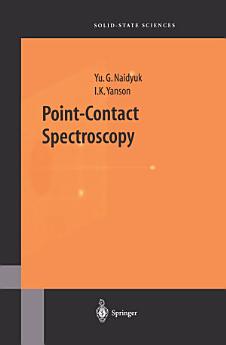Point-Contact Spectroscopy
Yu.G. Naidyuk · I.K. Yanson
abr. de 2019 · Springer Series in Solid-State Sciences Livro 145 · Springer
E-book
297
Páginas
reportAs notas e avaliações não são verificadas Saiba mais
Sobre este e-book
The main goal of solid-state physics is investigation of the properties of the matter including the mechanical, electrical, optical, magnetic, and so on with the aim of developing new materials with defined characteristics. Nowadays, the synthesis of superconductors with high critical temperature it consists of or fabrication of new heterostructures on the base of semiconductors, in cre ation of layered, amorphous, organic, or nanofabricated structures and many others. To do all of these, the various methods of investigation are developed during the past. Because it is impossible to find an universal method to in vestigate a variety of materials, which are either conducting or insulating, crystalline or amorphous, thin-layered or bulk, magnetic or segnetoelectric, and so on, various kind of spectroscopies, like optical, neutron, electron, tun nel and so on, are widely used in solid-state physics. Recently, a new type of spectroscopy, namely, the Point-Contact Spectroscopy (PCS), was designed for study of the conduction-electron interaction mechanism with a whole class of elementary excitations in the solids. In PCS, a small constriction, about a few nanometers large, between two conductors plays a role of a spectrome ter. Namely, because of inelastic scattering of accelerated electrons, the I - V characteristic of such a tiny metallic contact is nonlinear versus an applied voltage and its second derivative surprisingly turns out to be proportional to the electron-quasiparticle-interaction spectrum.
Sobre o autor
Both authors are affiliated with the B. Verkin Institute for Low Temperatire Physics and Engineering, National Academy of Sciences of Ukraine.
Avaliar este e-book
Diga o que você achou
Informações de leitura
Smartphones e tablets
Instale o app Google Play Livros para Android e iPad/iPhone. Ele sincroniza automaticamente com sua conta e permite ler on-line ou off-line, o que você preferir.
Laptops e computadores
Você pode ouvir audiolivros comprados no Google Play usando o navegador da Web do seu computador.
eReaders e outros dispositivos
Para ler em dispositivos de e-ink como os e-readers Kobo, é necessário fazer o download e transferir um arquivo para o aparelho. Siga as instruções detalhadas da Central de Ajuda se quiser transferir arquivos para os e-readers compatíveis.







